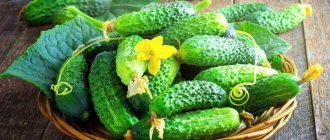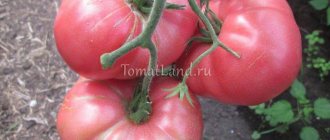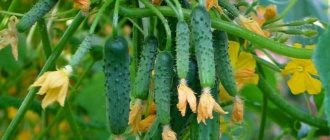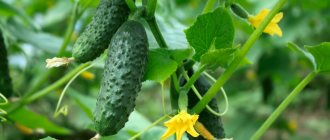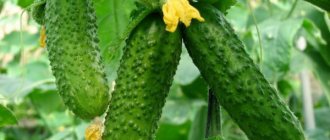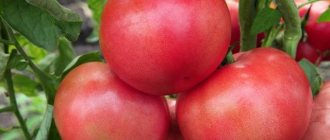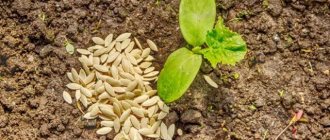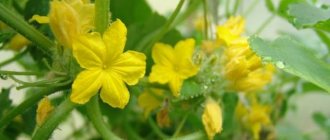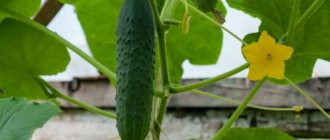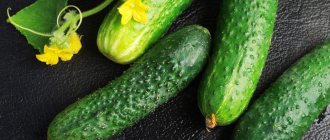Cucumber Crocodile Gena f1 is a highly productive parthenocarpic that shows stable fruiting in regions with different climates.
| Landing location | Ripening time | Mode of application | Fruit length | Group | Fruit smoothness | Pollination method |
| Universal | Early ripening (35-45 days) | Universal | Medium - from 10 to 15 cm | Hybrid | Highly lumpy | Parthenocarpic |
Description of Crocodile cucumbers
Cucumber Crocodile f1 is a hybrid crop bred by agro breeders for cultivation in open soil and in film or glass shelters.
Crocodile is a mid-season variety. The first greens ripen already 45 days after the formation of seedlings. Harvesting takes place over almost 4 months, until the first frost arrives.
Vegetable growers also note the versatility of using gherkins. Cucumbers are suitable for various processing methods (for canning, pickling), as well as for fresh consumption.
Characteristics of the variety:
- The hybrid plant belongs to the parthenocarpic varieties, since it does not need pollination by insects;
- The height of the bushes reaches 1.5-2 m with average branching and lateral branches of limited growth;
- Description of the ovaries: on the cucumber bushes, abundant ovaries are formed, in which 4 cucumbers ripen;
- The foliage of the variety is medium-sized, painted in a rich green color and has a rough surface;
- Description of the fruit: cucumbers grow up to 10 cm and have a cylindrical shape;
- The skin of the cucumber is dark green, loose, has small white stripes, large tubercles and black pubescence;
- Description of the pulp: the variety has firm, crispy and not watery pulp;
- Taste characteristics: sweet, aromatic cucumber, without bitterness.
In 2010, we decided to test a new type of cucumber for ourselves - the so-called Chinese cucumber or, in common parlance, “crocodiles.” They were named so for their original appearance: up to 50 cm long and covered with “pimples”, like our usual gherkins. For the first acquaintance we chose the hybrid “Emerald Stream”.
The seeds were sown in early April. The shoots appeared on the 4th day and were powerful. Large leaves began to grow very quickly. They were planted in a greenhouse on May 10th.
At the same time, we planted the Break cucumber, which is positioned as an extra-early one. So our “crocodiles” gave a harvest at the same time as Break: on June 4th there was the first cucumber. The quality of the cucumbers exceeded all expectations. Dense, crispy, at the same time very tender and aromatic. The skin is thin - ideal for salads. The size of the cucumbers surprised me: several of them were 50 cm long, but it seems they would have continued to grow if they had been given free rein.
For the experiment, some were cut into pieces and pickled. When prepared, the cucumbers were in no way inferior to ordinary ones either in taste or consistency. It’s just an unusual look, not everyone appreciated it. The stereotype of the ideal cucumber is very strong in Russia: 10 cm.
The next gathering was held a week later. And then it went - 1-2 cucumbers per plant per day. But, what is very important for summer residents, unpicked cucumbers do not outgrow for a long time, remaining tender and fresh, i.e. Collecting 1-2 times a week is quite enough, without loss of quality.
The plants themselves are very strong and disease resistant. The leaf is large, dark green. Powdery mildew was not detected during the entire growing season, although no special treatments were carried out, even the leaves were not thinned out and the old ones were not removed. The type of flowering is predominantly female. In addition, they are cold-resistant and shade-tolerant: they ended up in the depths of our greenhouse and did not suffer at all from this, as well as from the first autumn drops in temperature. Plants are strong and disease resistant. Productivity is good. Side shoots grow slowly. So there was no particular need to remove them.
We are very pleased with this hybrid. Although it was grown as a greenhouse plant, the annotation for the seeds says that it can also be grown in the ground. Well, let's try. Moreover, we decided to expand the range of this variety by adding two more hybrids: Chinese farmer and Chinese cold-resistant.
Having tested the two above-mentioned hybrids in 2011, we can say that in terms of yield and other qualities they are very much inferior to the Emerald Stream. The taste is extremely mediocre. The texture is hard. Apparently they can be stored for a very long time. The size is certainly impressive, but who needs it?
Photos of the cucumber can be seen in my photo album “Vegetable Jungle”.
Pros and cons of the variety
Since the Crocodile f1 hybrid is popular among vegetable growers, we can highlight a list of characteristics that describe both the positive and negative aspects of growing the variety. Below is a description of the pros and cons of cultivating Crocodile cucumber.
pros
The variety is famous for its high level of fruit productivity: up to 8 kg of crop is harvested from 1 m2 in open beds, and up to 15 kg in greenhouses;
- Long-term fruiting variety;
- Unlike the Tolstoy variety, Crocodile is famous for its versatility in the use of fruits;
- Excellent taste characteristics and presentation of cucumber;
- Crocodile f1 is resistant to changing weather conditions and temperature changes;
- Strong immunity of the hybrid to common infections;
- The fruits ripen relatively early;
- The cucumber pulp contains a small amount of seeds for the next sowing.
Minuses
Despite the list of positive characteristics, vegetable growers also highlight the disadvantages of cultivating the variety: the need for systematic watering of the bushes.
Reviews
Reviews of the variety in the public domain are rare. However, the few opinions of gardeners indicate the positive qualities of the crop. For example, Mikhail from Kazan reports that cucumber does not tolerate many diseases. He also uses the fruit in chopped form for salads and canning.
An experienced gardener from Russia showed video material indicating the high yield, long-term fruiting, and shade tolerance of the plant. He grows cucumber in a small greenhouse.
Green crocodile F1 is a hybrid variety with outstanding productivity that can be grown on your personal balcony. Cucumber is not whimsical. However, it produces fruits that meet the needs of culinary experts.
Landing Features
Experienced vegetable growers know that to obtain abundant fruiting and first-class fruits, it is necessary to plant the plant correctly. In this regard, experts offer a description of the main recommendations for growing the Crocodile f1 variety.
Landing dates
Direct sowing of Crocodile seeds is carried out in early June. If the variety is planted by seedlings, planting cucumber seeds begins in the first half of April.
Site preparation
Crocodile is a cucumber that prefers to grow in a warm place protected from the winds. As a rule, cucumbers are grown in the southern parts of the garden, since this side of the garden is the sunniest and not windiest.
To plant Crocodile seeds, in the fall the plot is dug up and fed with mineral components, such as manure or compost. It is also recommended to remove all weeds so that they cannot germinate in the spring.
Before planting cucumbers, the beds are loosened to a depth of 4 cm and the soil is fed with phosphorus or potassium components.
Planting seeds
It is recommended to plant the seeds of the variety in the soil after hardening and processing. The crop seed is usually treated in a 1% manganese solution. To do this, Crocodile seeds are soaked in the solution for half an hour and, after the appropriate time, removed on a dry cloth.
To harden cucumber seeds, they are dipped in hot water for a few minutes, and then placed in cold water for the same time. Afterwards, the Crocodile seeds are placed on cheesecloth and given time to dry.
Cucumbers are planted in open soil at a depth of 2 cm. It is recommended to place 2 seeds in each hole so that 1 of them germinates. Afterwards, the holes are buried and watered with warm water. In order for the sprouts to hatch, the beds are wrapped in film until bushes form.
Planting seedlings
Crocodile f1 seedlings are planted in 500 ml containers. Place several cucumber seeds in each container, sprinkle them with soil and water them. Next, the pots are removed in a warm room with lighting for at least 15 hours a day.
After the formation of bushes with full 4 leaves, the seedlings are transplanted into open soil. As a rule, it takes up to 30 days to grow Crocodile f1 seedlings. Cucumber bushes must be planted to a depth of 5 cm. Afterwards, the plant is sprinkled with earth and watered with warm water. The variety plant is also wrapped for several days.
Planting scheme
The cucumber variety must be planted at a distance of 30x30. This planting scheme ensures convenient harvesting and does not make it difficult to carry out the necessary agrotechnical procedures.
The last notes
Advantages of Docke Pie Premium soft roofing
Dec 15 • 163 Views
Slate roof guard and other safety features
Dec 14 • 132 Views
Lamonterra metal tiles: features of roofing material
Dec 14 • 131 Views
Types of apartment renovations
Nov 25 • 182 Views
Buying a display for Honnor 10
Nov 22 • 239 Views
Reinforced concrete columns: purpose, features, characteristics
Oct 19 • 468 Views
Gayafores heritage
Aug 25 • 1066 Views
Stretch ceilings in the hall Almaty-potolok.kz
Aug 19 • 344 Views
Invisible doors
Aug 1 • 409 Views
Boxes for storing vegetables in the cellar
Nov 15 • 483 Views
Boxes for planting tulips
Nov 15 • 371 Views
DIY wardrobe drawers
Nov 15 • 390 Views
Care
As a rule, the taste characteristics of a cucumber and the presence of any diseases directly depend on the work carried out to care for the Crocodile plant. The hybrid requires standard procedures: watering, fertilizing and hilling the soil, forming and tying up bushes. We invite you to familiarize yourself with the description of recommendations for agrotechnical procedures.
Watering
Crocodile f1 needs to be watered once every 3 days. During drought, watering works become more frequent to daily. Like other varieties, cucumbers are watered in the evening with warm water that has warmed up in the sun, or independently.
When watering, vegetable growers recommend making sure that the watering liquid does not get on the leaves of the plant. Otherwise, the Crocodile bushes weaken and become susceptible to disease.
Garter and bush formation
It is necessary to form a cucumber bush into 1 stem. As a rule, cucumbers are fixed to vertical trellises. The main stem must be tied. During formation, it is important to pay attention to ensure that the stem is not too tight. Vegetable growers also suggest shortening cucumber shoots by 3 leaves.
Top dressing
Crocodile f1 needs 5 feedings throughout the entire season. As a rule, the variety is fed with organic components, which contain manure or droppings. The variety also needs minerals - complex fertilizers containing potassium, saltpeter, superphosphate and potassium magnesium.
Hilling
It is recommended to hill up and loosen the soil of the beds once every 7 days. The procedures are carried out strictly after watering the plant. Loosening and hilling the soil helps remove the stagnant layer of soil, which does not allow moisture and oxygen to reach the Crocodile roots.
In addition, hilling helps to improve the root system and the development of new roots, and loosening ensures the removal of weeds that carry various diseases.
Advantages and disadvantages
The described cucumber appeared on the market not so long ago, but thanks to many positive characteristics it has already acquired admirers.
- The cucumber bears fruit early. It is convenient to grow in regions with short summers.
- The ovary is formed without the participation of insects.
- Resistant to temperature changes.
- The fruits set and ripen over a long period. In OG, greens are collected before the cold weather.
- High yields. Cucumber yields 16-18 kg per 1 m².
- Zelentsy are endowed with excellent taste and strong aroma.
The hybrid has no particular disadvantages.
Diseases and parasites
Experts say that Crocodile is a cucumber that is resistant to diseases such as powdery mildew, downy mildew and olive blight. However, experience in cultivating cucumber varieties shows that if care is not followed, the plant is susceptible to invasion by pests: aphids, thrips and whiteflies. To begin timely pest control, we suggest that you familiarize yourself with the description of the signs of insect appearance.
Aphid
Aphids are a small pest that settles in the beds at the time of flowering and formation of cucumber ovaries. As a result of the appearance of aphids, the Crocodile bushes begin to wither, and the leaves curl and fall off. To get rid of the small pest, experts recommend using the drugs “Aktara”, “Iskra-M” and “Bitoxibacillin”.
Thrips
Thrips is a pest of garden beds, as a result of which the plant stops developing, the leaves turn yellow, become covered with holes and fall off, and the flowers do not form cucumber ovaries. To control pests, Fitoverm, Karate, Aktelik and Karbofos are used.
Whitefly
Whitefly is an insect pest that causes the leaves to become covered with yellow and brown spots and a white coating to form. For prevention, vegetable growers suggest using the drugs “Arrivo”, “Iskra”, “Fufanon” and “Confidor”.
Advantages and disadvantages
The described cucumber appeared on the market not so long ago, but thanks to many positive characteristics it has already acquired admirers.
- The cucumber bears fruit early. It is convenient to grow in regions with short summers.
- The ovary is formed without the participation of insects.
- Resistant to temperature changes.
- The fruits set and ripen over a long period. In OG, greens are collected before the cold weather.
- High yields. Cucumber yields 16-18 kg per 1 m².
- Zelentsy are endowed with excellent taste and strong aroma.
The hybrid has no particular disadvantages.
